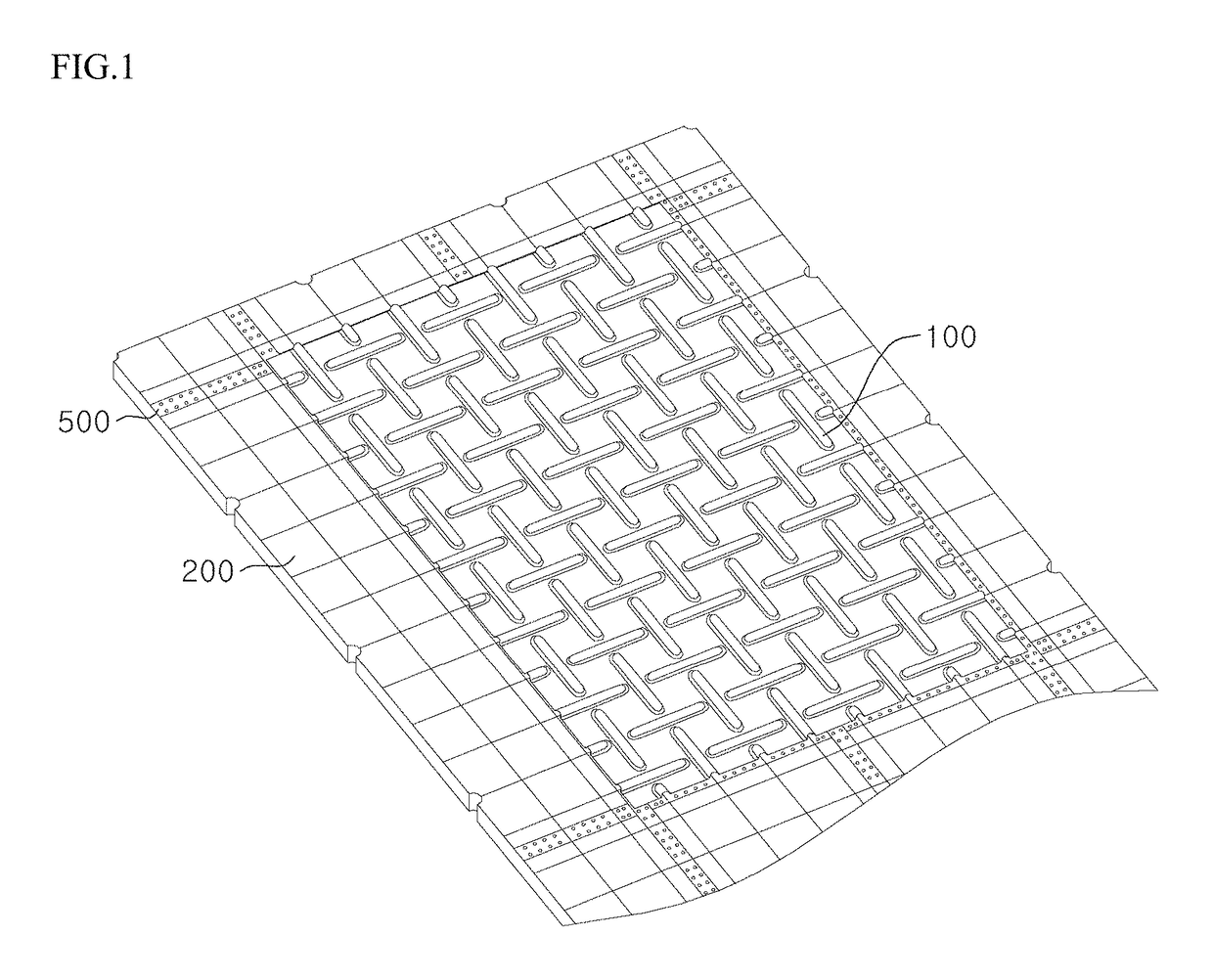Heat-insulation system for liquefied natural gas cargo hold
a technology of heat insulation system and liquefied natural gas, which is applied in the direction of vessel construction, transportation and packaging, vessel details, etc., can solve the problems of limited use of secondary sealing wall sus, wrinkles formed on secondary sealing wall cannot function properly, etc., and achieve high air tightness and competitive price
- Summary
- Abstract
- Description
- Claims
- Application Information
AI Technical Summary
Benefits of technology
Problems solved by technology
Method used
Image
Examples
first embodiment
[0053]FIG. 5 is a schematic perspective view of a heat-insulation system for an LNG cargo containment system according to the present invention and FIG. 6 is a side sectional view of the heat-insulation system of FIG. 5.
[0054]Referring to FIGS. 5 and 6, a method for manufacturing the heat-insulation system for an LNG cargo containment system according to this embodiment includes: welding one side 311 of a first membrane 310 to an outer edge of an upper surface of an anchor strip 500 and welding another side 312 of the first membrane 310 to a central portion of the upper surface of the anchor strip 500; forming a stepped portion having the same height as the first membrane 310 at one edge of the second membrane 320; placing one edge of the first membrane 310 under the stepped portion of the second membrane 320 and welding one side 321 of the second membrane 320 to an upper surface of the first membrane 310; welding another side 322 of the second membrane 320 to the central portion of...
second embodiment
[0057]FIG. 7 is a schematic side sectional view of a heat-insulation system for an LNG cargo containment system according to the present invention and FIG. 8 is a plan view of the heat-insulation system of FIG. 7.
[0058]Referring to FIGS. 7 and 8, a method for manufacturing the heat-insulation system for an LNG cargo containment system according to this embodiment includes: beveling a vertex 315, 325, 335 or 345 of each of first to fourth membranes 310, 320, 330, 340; disposing a vertical portion 620 of a collar stud 600 perpendicular to a setting plate 700; welding each side of the first membrane 310 to an upper surface of an anchor strip 500 and welding a beveled portion 315 at the vertex of the first membrane 310 to an upper surface of the setting plate 700; placing the third membrane 330 diagonally opposite the first membrane 310; welding each side of the third membrane 330 to the upper surface of the anchor strip 500 and welding a beveled portion 335 at the vertex of the third m...
third embodiment
[0063]FIG. 9 is a schematic side sectional view of a heat-insulation system for an LNG cargo containment system according to the present invention and FIG. 10 is a plan view of the heat-insulation system of FIG. 9.
[0064]Referring to FIGS. 9 and 10, a method for manufacturing the heat-insulation system for an LNG cargo containment system according to this embodiment includes: beveling a vertex 315, 325, 335, or 345 of each of first to fourth membranes 310, 320, 330, 340; placing a beveled portion 315 at the vertex where the first membrane 310 meets an upper surface of a setting plate 700 and welding each side of the first membrane 310 to an upper surface of an anchor strip 500; placing the third membrane 330 diagonally opposite the first membrane 310 such that a beveled portion 335 at the vertex of the third membrane 330 is located on the upper surface of the setting plate 700; welding each side of the third membrane 330 to the upper surface of the anchor strip 500; placing a beveled...
PUM
 Login to View More
Login to View More Abstract
Description
Claims
Application Information
 Login to View More
Login to View More - R&D
- Intellectual Property
- Life Sciences
- Materials
- Tech Scout
- Unparalleled Data Quality
- Higher Quality Content
- 60% Fewer Hallucinations
Browse by: Latest US Patents, China's latest patents, Technical Efficacy Thesaurus, Application Domain, Technology Topic, Popular Technical Reports.
© 2025 PatSnap. All rights reserved.Legal|Privacy policy|Modern Slavery Act Transparency Statement|Sitemap|About US| Contact US: help@patsnap.com



